#Petzval
Explore tagged Tumblr posts
Text

The last wildflowers of spring
Effects made in-camera
#photographers on tumblr#photography#original photographers#nature photography#western australia#australia#nature#landscape photography#lensblr#landscape#helios lens#helios#Petzval#wildflower#pink flowers#flower photography#flowers#flower#floral#female photographers#female artists#imiging#artists on tumblr#west-australian-wildflowers
122 notes
·
View notes
Text

RiNo Denver. 2024
2 notes
·
View notes
Text


My first results from "real" large format photography on actual film (as opposed to alternative methods like direct cyanotype).
Quick phone pictures snapped and inverted after development, while I wait for a chance to 3d-print the film holder for my scanner.
Shot on Arista Ortho Litho (rated for ISO 6) and developed at home in Cinestill df96 monobath.
#photography#large format photography#petzval#voigtlander und sohn#black and white film#film photography#film#film is not dead
3 notes
·
View notes
Text

Foudre violette sur fond violet, style photo ektachrome
Tatouage Éclair #foudre #violet #ektachrome #flickr #petzval85mm #filmhautevitesse #lignesintenses #photographie #16x9 #passionphoto
0 notes
Video
youtube
photoshoot with my 8x10 view camera 2023
2 notes
·
View notes
Text


Poor Things..
Petzval lens kullanımından film müziklerinin uyumuna kadar beğendiğim birçok detay var.
Sinemada izlenmeli 📽
6 notes
·
View notes
Video
Lens Test - Petzval/Cooke S8/Leica Cinescope/Sigma FF Classic from Andrea Gambadoro on Vimeo.
Testing some lenses at Shift4 using a Sony FX9 Lenses:
3 notes
·
View notes
Text
Discos estelares y emulsiones

Los objetivos antiguos como los Petzval potencian la nitidez en la región azul del espectro, ideal para emulsiones comunes en astrofotografía.
0 notes
Text
15 Riveting Images From The 2025 UN World Oceans Day Photo Competition
'The Ocean Is The Source of All Life And That Everything In Nature Is Deeply Connected.'
— By Popular Science Team | June 14, 2025
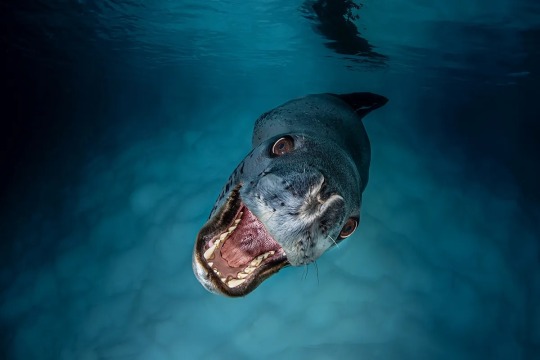
Big And Small Underwater Faces — 3rd Place! Trips To The Antarctic Peninsula Always Yield Amazing Encounters With Leopard Seals (Hydrurga Leptonyx. Boldly Approaching Me And Baring His Teeth, This Individual Was Keen To Point Out That This Part Of Antarctica Was His Territory. This Picture Was Shot At Dusk, Resulting In The Rather Moody Atmosphere. Credit: Lars Von Ritter Zahony, Germany 🇩🇪, World Ocean’s Day
The striking eye of a humpback whale named Sweet Girl peers at the camera. Just four days later, she would be dead, hit by a speeding boat and one of the 20,000 whales killed by ship strikes each year. Photographer Rachel Moore’s captivating image (seen below) of Sweet Girl earned top honors at the 2025 United Nations World Oceans Day Photo Competition.

Top: Wonder: Sustaining What Sustains Us — Winner! This photo, taken in Mo’orea, French Polynesia in 2024, captures the eye of a humpback whale named Sweet Girl, just days before her tragic death. Four days after I captured this intimate moment, she was struck and killed by a fast-moving ship. Her death serves as a heartbreaking reminder of the 20,000 whales lost to ship strikes every year. We are using her story to advocate for stronger protections, petitioning for stricter speed laws around Tahiti and Mo’orea during whale season. I hope Sweet Girl’s legacy will spark real change to protect these incredible animals and prevent further senseless loss. Credit: Rachel Moore (USA 🇺🇸)
Bottom: Underwater Seascapes — Honorable Mention! With only orcas as their natural predators, leopard seals are Antarctica’s most versatile hunters, preying on everything from fish and cephalopods to penguins and other seals. Gentoo penguins are a favored menu item, and leopard seals can be observed patrolling the waters around their colonies. For this shot, I used a split image to capture both worlds: the gentoo penguin colony in the background with the leopard seal on the hunt in the foreground. Credit: Lars von Ritter Zahony (Germany 🇩🇪)
Now in its twelfth year, the competition coordinated in collaboration between the UN Division for Ocean Affairs and the Law of the Sea, DivePhotoGuide (DPG), Oceanic Global, and the Intergovernmental Oceanographic Commission of UNESCO. Each year, thousands of underwater photographers submit images that judges award prizes for across four categories: Big and Small Underwater Faces, Underwater Seascapes, Above Water Seascapes, and Wonder: Sustaining What Sustains Us.
This year’s winning images include a curious leopard seal, a swarm of jellyfish, and a very grumpy looking Japanese warbonnet. Given our oceans’ perilous state, all competition participants were required to sign a charter of 14 commitments regarding ethics in photography.

Top: Above Water Seascapes – Winner! A serene lake cradled by arid dunes, where a gentle stream breathes life into the heart of Mother Earth’s creation: Captured from an airplane, this image reveals the powerful contrasts and hidden beauty where land and ocean meet, reminding us that the ocean is the source of all life and that everything in nature is deeply connected. The location is a remote stretch of coastline near Shark Bay, Western Australia. Credit: Leander Nardin (Austria 🇦🇹)
Bottom: Above Water Seascapes — 3rd Place! Paradise Harbour is one of the most beautiful places on the Antarctic Peninsula. When I visited, the sea was extremely calm, and I was lucky enough to witness a wonderfully clear reflection of the Suárez Glacier (aka Petzval Glacier) in the water. The only problem was the waves created by our speedboat, and the only way to capture the perfect reflection was to lie on the bottom of the boat while it moved towards the glacier. Credit: Andrey Nosik (Russia 🇷🇺)
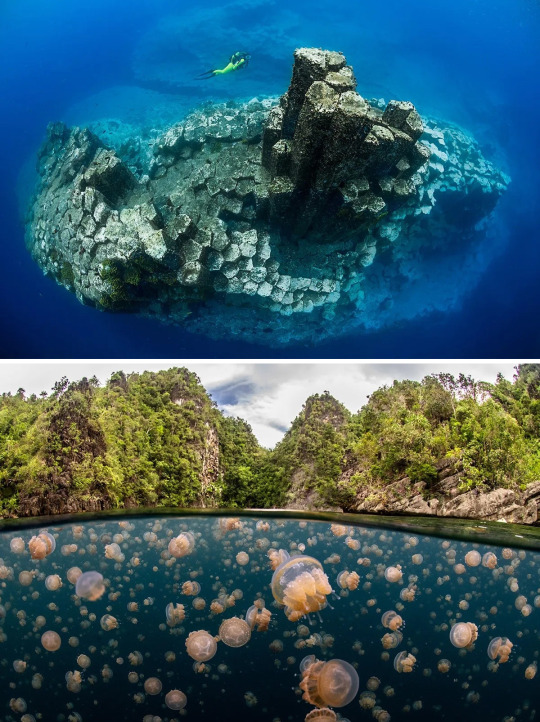
Top: Underwater Seascapes — 3rd Place! “La Rapadura” is a natural hidden treasure on the northern coast of Tenerife, in the Spanish territory of the Canary Islands. Only discovered in 1996, it is one of the most astonishing underwater landscapes in the world, consistently ranking among the planet’s best dive sites. These towering columns of basalt are the result of volcanic processes that occurred between 500,000 and a million years ago. The formation was created when a basaltic lava flow reached the ocean, where, upon cooling and solidifying, it contracted, creating natural structures often compared to the pipes of church organs. Located in a region where marine life has been impacted by once common illegal fishing practices, this stunning natural monument has both geological and ecological value, and scientists and underwater photographers are advocating for its protection. (Model: Yolanda Garcia) Credit: Pedro Carrillo (Spain 🇪🇸)
Bottom: Underwater Seascapes — Winner! This year, I had the incredible opportunity to visit a jellyfish lake during a liveaboard trip around southern Raja Ampat, Indonesia. Being surrounded by millions of jellyfish, which have evolved to lose their stinging ability due to the absence of predators, was one of the most breathtaking experiences I’ve ever had. Credit: Dani Escayola (Spain 🇪🇸)

Top: Underwater Seascapes — 2nd Place! This shot captures a school of rays resting at a cleaning station in Mauritius, where strong currents once attracted them regularly. Some rays grew accustomed to divers, allowing close encounters like this. Sadly, after the severe bleaching that the reefs here suffered last year, such gatherings have become rare, and I fear I may not witness this again at the same spot. Credit: Gerald Rambert (Mauritius 🇲🇺)
Bottom: Wonder: Sustaining What Sustains Us — 3rd Place! Shot in Cuba’s Jardines de la Reina—a protected shark sanctuary—this image captures a Caribbean reef shark weaving through a group of silky sharks near the surface. Using a slow shutter and strobes as the shark pivoted sharply, the motion blurred into a wave-like arc across its head, lit by the golden hues of sunset. The abundance and behavior of sharks here is a living symbol of what protected oceans can look like. Credit: Steven Lopez (USA 🇺🇸)
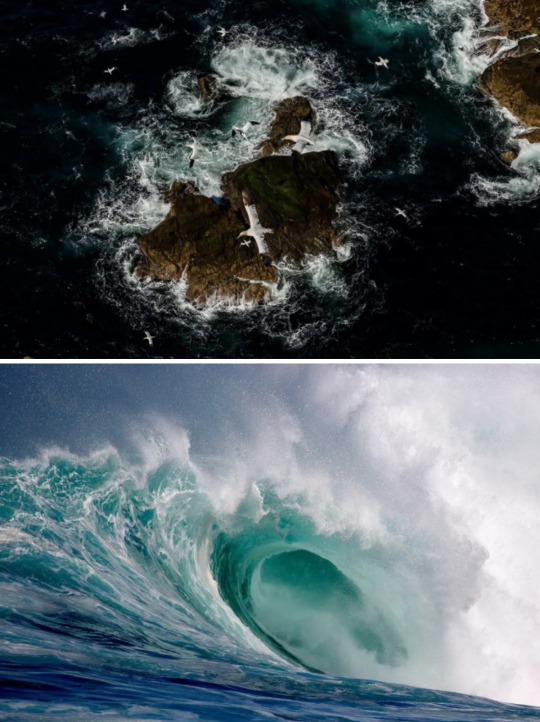
Top: Above Water Seascapes — 2nd Place! Northern gannets (Morus bassanus) soar above the dramatic cliffs of Scotland’s Hermaness National Nature Reserve, their sleek white bodies and black-tipped wings slicing through the Shetland winds. These seabirds, the largest in the North Atlantic, are renowned for their striking plunge-dives, reaching speeds up to 100 kph (60 mph) as they hunt for fish beneath the waves. The cliffs of Hermaness provide ideal nesting sites, with updrafts aiding their take-offs and landings. Each spring, thousands return to this rugged coastline, forming one of the UK’s most significant gannet colonies. It was a major challenge to take photos at the edge of these cliffs at almost 200 meters (650 feet) with the winds up to 30 kph (20 mph). Credit: Nur Tucker (UK 🇬🇧/ Türkiye 🇹🇷)
Bottom: Above Water Seascapes — Honorable Mention! A South Atlantic swell breaks on the Dungeons Reef off the Cape Peninsula, South Africa, shot while photographing a big-wave surf session in October 2017. It’s the crescendoing sounds of these breaking swells that always amazes me. Credit: Ken Findlay (South Africa 🇿🇦)
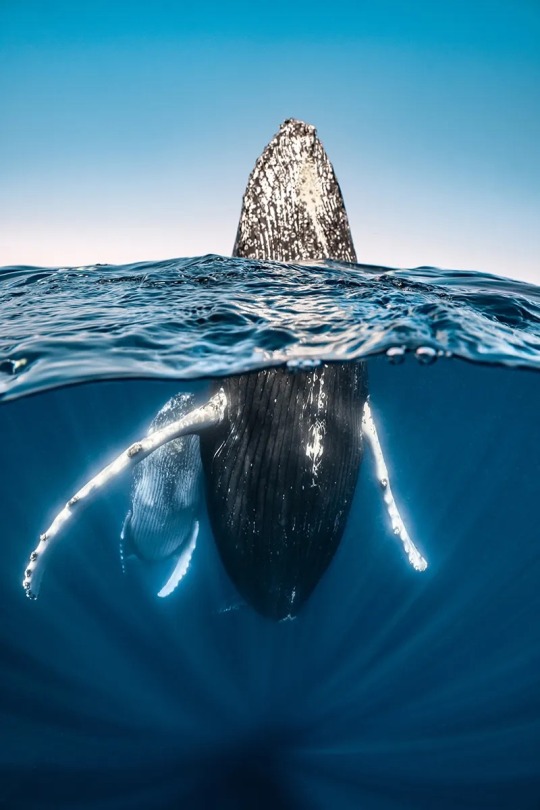
Wonder: Sustaining What Sustains Us — Honorable Mention! Humpback whales in their thousands migrate along the Ningaloo Reef in Western Australia every year on the way to and from their calving grounds. In four seasons of swimming with them on the reef here, this is the only encounter I’ve had like this one. This pair of huge adult whales repeatedly spy-hopped alongside us, seeking to interact with and investigate us, leaving me completely breathless. The female in the foreground was much more confident than the male behind and would constantly make close approaches, whilst the male hung back a little, still interested but shy. After more than 10 years working with wildlife in the water, this was one of the best experiences of my life. Credit: Ollie Clarke (UK 🇬🇧)
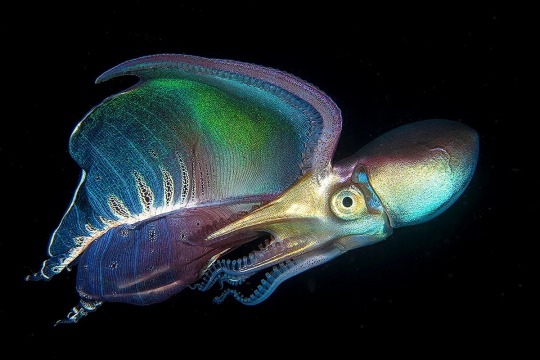
Big and Small Underwater Faces — 2nd Place! On one of my many blackwater dives in Anilao, in the Philippines, my guide and I spotted something moving erratically at a depth of around 20 meters (65 feet), about 10 to 15 centimeters in size. We quickly realized that it was a rare blanket octopus (Tremoctopus sp.). As we approached, it opened up its beautiful blanket, revealing its multicolored mantle. I managed to take a few shots before it went on its way. I felt truly privileged to have captured this fascinating deep-sea cephalopod. Among its many unique characteristics, this species exhibits some of the most extreme sexual size-dimorphism in nature, with females weighing up to 40,000 times more than males. Credit: Giacomo Marchione (Italy 🇮🇹)
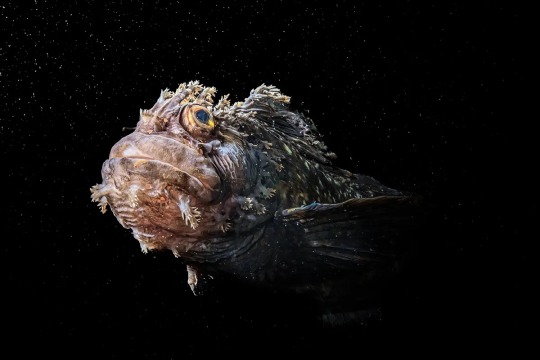
Big and Small Underwater Faces – Winner! This photo of a Japanese warbonnet (Chirolophis japonicus) was captured in the Sea of Japan, about 50 miles (80 kilometers) southwest of Vladivostok, Russia. I found the ornate fish at a depth of about 30 meters (100 feet), under the stern of a shipwreck. This species does not appear to be afraid of divers—on the contrary, it seems to enjoy the attention—and it even tried to sit on the dome port of my camera. Credit: Andrey Nosik (Russia 🇷🇺)

Wonder: Sustaining What Sustains Us — 2nd Place! A juvenile pinnate batfish (Platax pinnatus) captured with a slow shutter speed, a snooted light, and deliberate camera panning to create a sense of motion and drama. Juvenile pinnate batfish are known for their striking black bodies outlined in vibrant orange—a coloration they lose within just a few months as they mature. I encountered this restless subject in the tropical waters of Indonesia’s Lembeh Strait. Capturing this image took patience and persistence over two dives, as these active young fish constantly dart for cover in crevices, making the shot particularly challenging. Credit: Luis Arpa (Spain 🇪🇸)
—United Nations 🇺🇳, World Oceans Day, WWW.UNWorldOceansDay.Org
#United Nations 🇺🇳#World Ocean’s Day#Miscellaneous Photographs#Riveting Images#2025 UN World Oceans Day Photo Competition#Oceans: The Source of All Life#Nature’s Deep Connection#Popular Science Team#PopSci.Com#Environment#Animals#Whales 🐋 🐳#Fish 🐠🐡🐟#Sharks 🦈🦈🦈#Lakes#Antarctica 🇦🇶#Antarctic Peninsula#Rare Blanket Octopus 🐙
1 note
·
View note
Text

New shooting nikon f2 petzval Lens lomo thanks my gorgeous and lovely @crystalsuicidegirls …..
analogphotography #believeinfilm #filmphotography #photography #filmisnotdead #kodak #filmphotographic #kodaklosers #analoguepeople #shootfilmmag #filmcommunity #shotonfilm #madewithkodak #grainisgood #broadmag #filmshooterscollective #portraitphotography
0 notes
Text


First camera scans of my first proper negative photos from my large format camera and antique Voigtlander Petzval lens.
2 notes
·
View notes
Video
Flower of September by Katsuaki Shoda Via Flickr: Canon EOS 5DS R + Lomography Zenit Petzval 85mm f/2.2
#Kobe#Hyogo#Japan#Flower#No People#Nature#Petal#Plant#Flower Head#Summer#Botany#Freshness#Blossom#Close-up#Beauty In Nature#Beauty#flickr
1 note
·
View note
Text
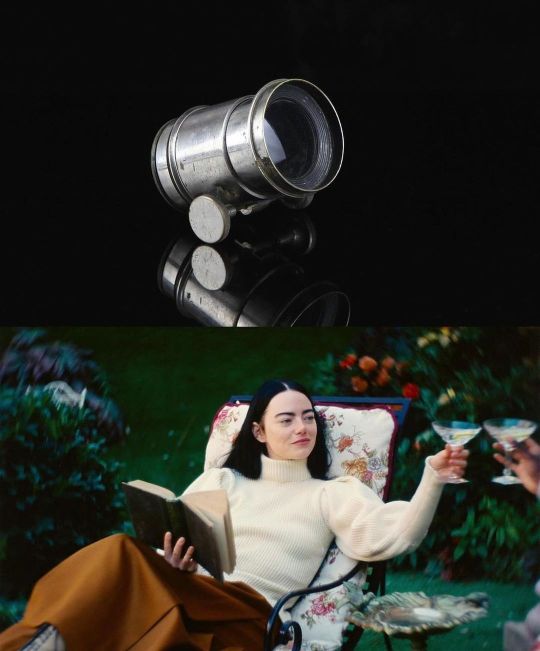



The excellent camerawork in Poor Things (2023)
Antique Petzval glass.
4mm s16 lens modified for 35mm.
10mm Arri Ultra Prime
Arri / Zeiss 16.5 - 110 Master Prime.
🎥fuckinggoodmoviesT
0 notes
Text
Production Processes (Supporting Post)
For the rural scenes there were physical challenges and risks mainly with equipment moving. For the entire piece my main camera was a BlackMagic design, Pocket Cinema Camera 6k Pro. Whilst being a compact form-factor camera, hiking equipment up rural hills became physically difficult due to weight distribution when combined with lenses and a tripod. The weight and size of the kit caused challenge and risk with getting up and down the locations I wanted during daylight hours as to prevent any risks associated with limited light. These risks were thankfully further mitigated where I was able to get help to securely transport myself and kit by car to these locations which always ensured safety of myself and the kit.
For the urban scenes I used London as my backdrop due to its ease of access from Kent and Leeds as well as for its stark iconography. For the first 2 filming days in London, I used a compact rig of the 6k Pro, taking minimal equipment, with no tripod and fewer lenses. This was to mitigate risk associated with equipment safety like theft as well as weight risks. This meant that I had to be careful in my lens choice and limited the type of shots I could get from the lack of a tripod. I ended up opting for a 58mm Petzval Lomography lens which provided the rounded depth of field bokeh control in the two shots below that made the final cut. Secondarily I used a 24-105mm zoom lens which provided greater versatility and produced most of the footage from those dates. On the third London filming date I only took a DSLR camera with no video function which is where I took all the ‘frame by frame’ sequences of the final project using 100s of photos. These three days were well planned and involved exact routes and lists of the types of edits I wanted. This helped time factors and made the production workflow more efficient.
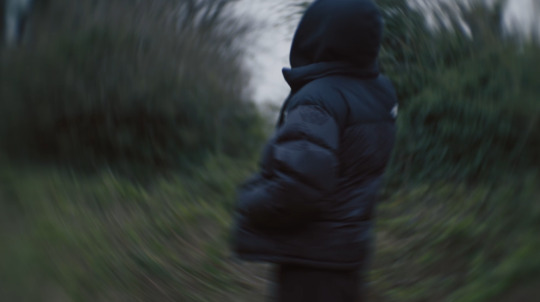
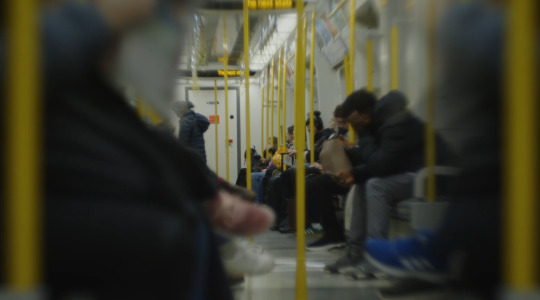
The shoots at home in Kent filled in all the gaps of footage I needed and provided many of the more conventionally narrative sequences of the project. I used my living room as the backdrop for the shots below, which proved to be smooth filming sessions with minimal risks and complications where I had a controlled and private location. For these scenes I had unlimited amounts of time to experiment with the angles, lens choices, mise-en scene and lighting. For the ‘Sofa Shot’ I framed the shot with as many plants I could find which created a delicately, natural contrasted mise-en-scene. I was also able to film this scene with only natural light by positioning the curtains in a specific way to shape the way the light entered the scene.
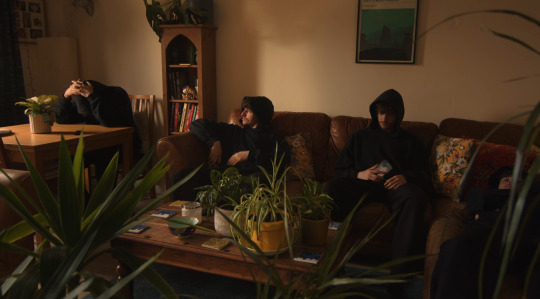
0 notes



